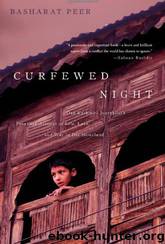Curfewed Night: One Kashmiri Journalist's Frontline Account of Life, Love, and War in His Homeland by Basharat Peer

Author:Basharat Peer [Peer, Basharat]
Language: eng
Format: epub
Publisher: GAPPAA.ORG
Published: 2015-03-08T16:00:00+00:00
Srinagar is a medieval city dying of a modern war. It is empty streets, locked shops, angry soldiers, and boys with stones. It is several thousand military bunkers, four golf courses, and three half-decent bookshops. It is wily politicians repeating their lies about war and peace to television cameras and small crowds gathered by the promise of an elusive job or a daily fee of a few hundred rupees. It is stopping on sidewalks and at traffic lights when the convoys of rulers and their patrons in armored cars secured by machine guns rumble on broken roads. It is staring back or looking away, resigned. Srinagar is never winning and never being defeated.
Srinagar newspapers regularly carry obituaries of dead rebels with young somber faces along with the elegies for the smiling, aging men in expensive suits who guard the gates of privilege. Some print headlines in red, announcing deaths. Some run a box on the front page, giving the daily updated statistics. Srinagar is being in a coffee shop, in an office, outside a college, crossing a bridge, and feeling, touching, breathing history, politics, and war, in unmarked signs and landmarks. Srinagar is seeing a bridge, a clearing, a nondescript building and knowing that men fell here, that a boy was tortured there.
As a reporter, I had the chance to meet Merajuddin, a veteran Kashmiri news photographer, who looked the part in his photographer’s jacket. Merajuddin always wore dark sunglasses after he lost his left eye to a splinter from a hand grenade. I once asked him how he had dealt with the violence he encountered as a photographer. He spoke like a man who had seen it all. “I cried like a child when the protesters were massacred at Gawkadal Bridge. Nothing I saw after that made me cry.” I remember sitting with my family in my village and hearing the news of the Gawkadal massacre on the BBC World Service; most eyes were moist. The next afternoon I walked with the young and old, men and women, boys and girls of my village shouting slogans in a protest against the massacre. I was too young to understand how brutal brutality could be. But as I grew up and began to understand, the memory haunted me.
Gawkadal was a few hundred yards from Lal Chowk. One afternoon as I was crossing Lal Chowk, a crowd of girls in bright white uniforms emerged from the gates of the nearby women’s college, causing a stir amid the clusters of boys loitering around like awkward clones of pop stars. It was the only moment when you saw so many Kashmiri women, who always preferred bright pink, red, blue, and green, wearing white. The boys in a rainbow of T-shirts and regulation denims seemed awestruck. Seeing them reminded me of a recent cartoon in a local newspaper that had depicted a boy holding a begging bowl outside the women’s college.
It was a scene that repeated itself every afternoon outside every college and school in Kashmir.
Download
This site does not store any files on its server. We only index and link to content provided by other sites. Please contact the content providers to delete copyright contents if any and email us, we'll remove relevant links or contents immediately.
| China | India & South Asia |
| Japan |
Fanny Burney by Claire Harman(26530)
Empire of the Sikhs by Patwant Singh(22980)
Out of India by Michael Foss(16792)
Leonardo da Vinci by Walter Isaacson(13189)
Small Great Things by Jodi Picoult(7024)
The Six Wives Of Henry VIII (WOMEN IN HISTORY) by Fraser Antonia(5399)
The Wind in My Hair by Masih Alinejad(5034)
A Higher Loyalty: Truth, Lies, and Leadership by James Comey(4851)
The Lonely City by Olivia Laing(4751)
The Crown by Robert Lacey(4731)
Millionaire: The Philanderer, Gambler, and Duelist Who Invented Modern Finance by Janet Gleeson(4386)
The Iron Duke by The Iron Duke(4294)
Papillon (English) by Henri Charrière(4199)
Sticky Fingers by Joe Hagan(4106)
Joan of Arc by Mary Gordon(4021)
Alive: The Story of the Andes Survivors by Piers Paul Read(3970)
Stalin by Stephen Kotkin(3883)
Aleister Crowley: The Biography by Tobias Churton(3589)
Ants Among Elephants by Sujatha Gidla(3417)
